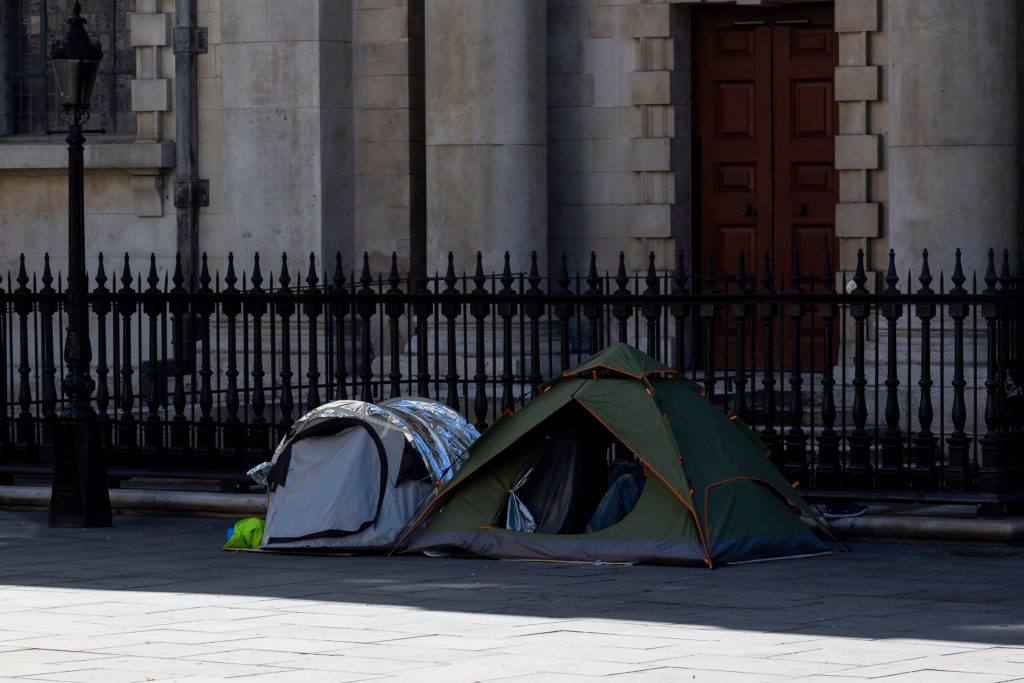The rising trend of youth homelessness in England is driven by a complex interplay of factors. The breakdown of family relationships often triggered by conflicts, abuse, or neglect, coupled with mental health challenges and financial hardships, appears as the leading causes. Presently, approximately 271,000 individuals, including 123,000 children, are documented as homeless in England. Homeless children face challenges in education, and increased risks of adverse experiences, emphasizing the urgent need for stable, secure living environments to protect their rights and well-being.
Exploring the evolution and meaning of homelessness
In the UK, the prevalence of people without shelter became widespread following World War II due to a shortage of affordable housing. The Housing (Homeless Persons) Act of 1977 restricted specific groups from residing in desirable areas, affecting low-income families. This, coupled with urbanization attracting more individuals to cities, resulted in overcrowding and substandard living conditions (Greater Change, 2022).
The Housing Act of 1977 mandated local authorities to provide accommodation for homeless individuals and those at risk, including young people living in difficult circumstances. While it’s true that the approach to homelessness has changed for the better since the 1930s, residency deprivation remains a significant issue, with a rise in people seeking help and an increase in rough sleeping (Greater Change, 2022).
When examining “core” homelessness, it’s pivotal to underscore its diverse facets, encompassing rough sleeping, unconventional living arrangements, and inadequate temporary accommodations. Over the past years, England has witnessed a consistent uptick in the number of homeless individuals, reaching a pinnacle of over 219,000 homeless households in 2019 (Crisis UK, n.d.).
Factors driving youth houselessness

Growing youth homelessness in England results from a confluence of factors. The breakdown of family relationships stands out as a leading cause, often triggered by conflicts, domestic abuse, neglect, substance misuse problems, or parental disputes. Mental health challenges contribute significantly, exacerbated by a lack of access to health services and counseling support, forming a distressing cycle for affected youth (Action for Children, 2023).
Financial hardships and child poverty are also pervasive drivers, with many young people forced to leave home due to their families’ inability to provide adequate living conditions. Additionally, African, Asian, and other minority ethnic communities, refugees, and asylum seekers face increased vulnerabilities, often stemming from social inequalities, trauma, and limited access to support networks, heightening their susceptibility to housing insecurities (Action for Children, 2023).
Several other contributing factors have led to this distressing surge in the lack of shelter in the country. Government welfare cuts, a dire shortage of affordable housing, and soaring rents have been identified as key culprits behind the escalating numbers of individuals compelled to seek temporary accommodation provided by the state (Greenfield P, 2018).
In July 2023, the UK Government quietly disclosed that an estimated additional 5,030 children in England have recently slipped into homelessness this year. This represents a 10% surge—equivalent to 12,640 children—since the commencement of the cost-of-living crisis in late 2021 (Just Fair, 2023).
Presently, it is estimated that at least 271,000 individuals are documented as homeless, among them 123,000 children. This means that approximately one in every 208 individuals in England is without a home, comprising various categories: 2,400 people sleeping rough nightly, 15,000 individuals in hostels or supported accommodations, and almost 250,000 residing in temporary housing, notably families (Shelter England, 2023).
Impact on young people’s lives
For children facing residency deprivation, residing in emergency accommodations poses significant challenges. Sharing a confined space with family members after an eviction, they encounter difficulties in finding room for activities like reading or playing without interruptions. Concentrating on homework becomes a struggle due to limited space and distractions, hindering their ability to study quietly (Shelter England, 2019).
There’s also the aspect of social isolation, particularly pronounced among homeless secondary school students due to limited access to facilities, resulting in unwashed uniforms and hair. This isolation leads to low self-esteem, distractions from schoolwork, and heightened anxiety, especially among adolescents, potentially making them susceptible to bullying (Phillips Amy, 2019).
Additionally, homeless children face a higher risk of adverse childhood experiences, including uncertainties and frequent environmental changes that disrupt trust and routine. Coupled with vulnerabilities to drug abuse, domestic violence, and sexual abuse from the individuals they stay with, these adverse experiences detrimentally affect their development and increase the likelihood of future mental health issues (Phillips Amy, 2019).
The detrimental effects of homelessness become apparent, particularly among individuals, especially children, enduring extended stays in such accommodations. Isolation, restricted access to vital support services, and living in inadequate conditions without essential facilities for basic needs like laundry or cooking are distressing outcomes (Greenfield P, 2018).
Government response and interventions
Although the government declared in 2019 its relentless commitment to eradicating homelessness, the current state of the youth housing crisis remains dire. Data suggests that the count of 16- to 24-year-olds reaching out to councils as homeless is constantly surging. This increase translates to over 370 individuals seeking assistance daily – totaling a staggering 135,733 young people in need within a year (Booth R, 2023).
The government did take several steps to address the issue through the Homelessness Reduction Act (HRA) that came into effect in April 2018. The HRA introduced new duties for housing authorities, mandating local authorities to provide free information and guidance on preventing homelessness, securing accommodation, tenants’ rights, benefit entitlements, debt management, and addressing issues related to violence and abuse (Fenland District Council, n.d.).
However, despite these efforts, there appears to be a gap between the policies in place and their effectiveness in curbing the escalating youth housing crisis. To effectively tackle youth housing insecurities in England, prioritizing preventative strategies is crucial. Establishing safe spaces offering health services regardless of a stable residence, alongside sustained funding, is essential (Phillips Amy, 2019).
These initiatives aim to curb the suffering and health challenges faced by homeless youth, providing crucial support and opportunities for a stable future. Additionally, researching and evaluating these programs are essential for ongoing improvement and gaining insight into the reasons why young individuals lack shelter.

At Humanium, we are dedicated to creating a world where every child’s rights are honored and safeguarded. If you resonate with our vision and would like to bolster our cause, kindly consider sponsoring a child, contributing through donations, or volunteering with us.
Written by Lidija Misic
Bibliography
Action for Children (2023), What are the main causes of youth homelessness in the UK? Retrieved from Action for Children at https://www.actionforchildren.org.uk/blog/what-are-the-main-causes-of-youth-homelessness-in-the-uk/. Accessed on December 28, 2023.
Booth Robert (2023), Hundreds seek council help every day in the UK youth homelessness crisis. Retrieved from The Guardian at https://www.theguardian.com/society/2023/nov/05/hundreds-seek-council-help-every-day-in-uk-youth-homelessness-crisis. Accessed on December 28, 2023.
Crisis UK (n.d.), About homelessness. Retrieved from Crisis UK at https://www.crisis.org.uk/ending-homelessness/about-homelessness/. Accessed on December 28, 2023.
Fenland District Council (n.d.), Homelessness Reduction Act (HRA). Retrieved from Fenland District Council at https://www.fenland.gov.uk/article/14244/Homelessness-Reduction-Act-HRA. Accessed on December 28, 2023.
Greater Change (2022), When did homelessness begin in the UK? Retrieved from Greater Change at https://www.greaterchange.co.uk/post/when-did-homelessness-begin-in-the-uk. Accessed on December 28, 2023.
Greenfield Patrick (2018), Child homelessness in England at the highest level since 2007. Retrieved from The Guardian at https://www.theguardian.com/society/2018/jun/27/child-homelessness-in-england-at-highest-level-since-2007. Accessed on December 28, 2023.
Just Fair (2023), Record levels of children experiencing homelessness – this is a rights issue. Retrieved from Just Fair at https://justfair.org.uk/record-levels-of-children-experiencing-homelessness-this-is-a-rights-issue/. Accessed on December 28, 2023.
Phillips Amy (2019), Homelessness and its impact on children. Retrieved from The Association for Child and Adolescent Mental Health (ACAMH) at https://www.acamh.org/blog/homelessness-impacts-on-children/. Accessed on December 28, 2023.
Shelter England (2019), A child becomes homeless in Britain every eight minutes. Retrieved from Shelter England at https://england.shelter.org.uk/media/press_release/a_child_becomes_homeless_in_britain_every_eight_minutes. Accessed on December 28, 2023.
Shelter England (2023), At least 271,000 people are homeless in England today. Retrieved from Shelter England at https://england.shelter.org.uk/media/press_release/at_least_271000_people_are_homeless_in_england_today. Accessed on December 28, 2023.


